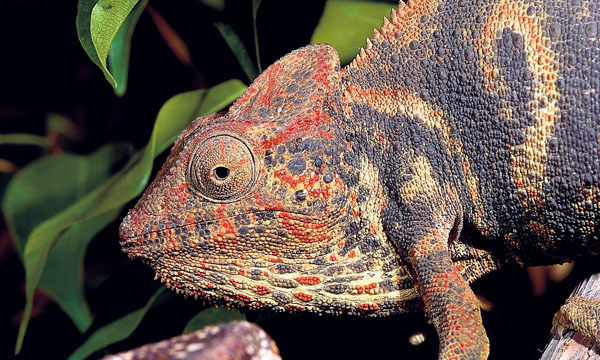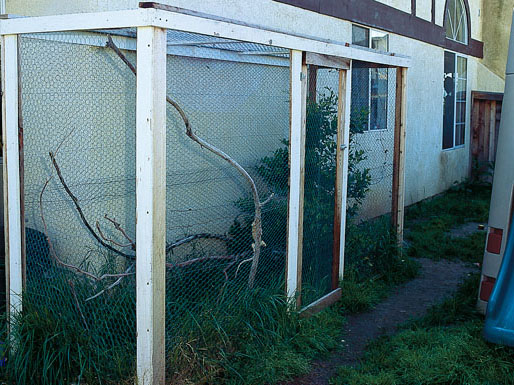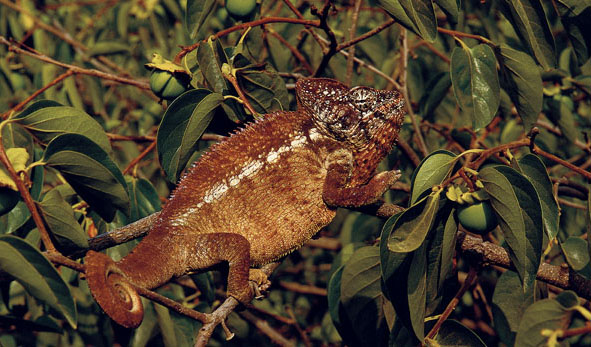The Oustalet’s chameleon is one of the world’s largest, and adults can attain a maximum length of about 2 feet.
One of my first breeding projects in the early 1990s was with the Oustalet’s chameleon (Furcifer [Chamaeleo] oustaleti), the giant chameleon from Madagascar’s spiny desert. Sticky Tongue Farms was just beginning, and one day I received a call from a man who needed to find a home for his chameleon because his wife didn’t like it. I agreed to pick up the lizard.
I had never seen a captive-bred Oustalet’s before, and this man had hatched his pet, named Oliver, on his own with little breeding information available to him. This impressed me. The man was adamant that I take Oliver only if I would promise to never sell him because Oliver was his baby. When I saw Oliver I knew he was special. He had so much personality and spirit. He was a gentle giant.
I brought Oliver home to the farm, where he would later breed with the females of his choice. He liked to ride on the handlebars of my bike. Flattened out and black to soak up the sun, he would often sit on my hat while eating flies as I did my gardening. His coloration was not as flashy as a panther chameleon’s, but what he lacked in flash he made up for in personality. The squamation (scale configuration/pattern) on his large body was fascinating. Oliver is the reason I became forever amazed by breeding chameleons.
Signs of Health
If you’re buying imported or store-bought Oustalet’s, go through the usual checklist of ailments. Dehydration is the number one priority because this is usually symptomatic of another condition, such as parasites, stress or improper care. The chameleon’s skin should be plump. Eyes should be bright, round and alert. Mouths should be free of lesions or abrasions.

Photo by Linda Davison
Oustalet’s are often considered chameleons for advanced herpers. One reason is their size. Another might be because of the heavy parasite load wild-caught specimens may contain.
The parasite load of imported F. oustaleti can be high. I have had more difficulty getting rid of the parasites in this species than any other with which I’ve worked. Because of the size and severe parasite load possible, I highly recommend a veterinarian experienced with chameleons handle the treatment. If the chameleon’s parasite count is low and the problem is taken care of quickly, there is a good chance for a long, healthy life.
The parasite check-treatment regimen I have used with success is as follows: Always get a fecal check, so you know what you are dealing with. If needed, a round of Panacur medication is my first course of action. This is followed by Flagyl if necessary. After both treatments are completed a follow-up fecal exam is done. If all tests are clean, I get a blood test to rule out any other possible parasites. If all are negative, I wait three months and get another fecal. If the veterinarian says it’s necessary, I repeat the process.
I recommend an annual fecal exam as a preventative measure for all chameleons even if they’re captive bred. Oustalet’s are often labeled as “advanced” chameleons, and I believe this may be due to the parasite issue or the cost of the parasite-removal treatments involved. Once the parasite problem is resolved, however, Oustalet’s are pretty much bulletproof in my experience.
Large Cages a Must
I encourage chameleon enthusiasts to as closely as possible simulate a species’ natural environment in an outdoor situation. An outdoor enclosure with the closest possible match to the chameleon’s natural habitat affords a longer, healthier life for your chameleon, and automated systems make cleaning and watering easier. Chameleons kept outdoors can catch wild insects, too.

Photo by Linda Davison
Large outdoor enclosures that mimic the Oustalet’s natural habitat are recommended. This is one of the author’s Furcifer oustaleti enclosures..
The Oustalet’s chameleon is one of the world’s largest, and adults can attain a maximum length of about 2 feet. Therefore, they need large enclosures. A single adult should be kept in a screened enclosure measuring at least 4 feet tall, 3 feet wide and 3 feet deep. Indoor enclosures need a dome light with an incandescent bulb to provide a hotspot, as well as reptile-specific UVB fluorescent lights on top of the enclosure. A cool-mist humidifier with an automatic timer is also recommended to combat dehydration, especially if the area in which you live can get hot and dry (see “The Shower Method” sidebar for more about proper hydration).
Some keepers build custom enclosures. As a rule, taller enclosures are better. Keep in mind during construction to make it verminproof using tough screening that rodents would not be able to chew through. Don’t use chicken wire as this can injure a chameleon’s feet. I recommend constructing enclosures using the PVC-coated fencing found at home-improvement centers. It is sold in one-fourth-inch and half-inch square mesh.
Someday you might have a gravid female in egg-laying mode in the enclosure, and it will be digging into the substrate. Be sure you construct the enclosure in such a way as to prevent her from digging out of it. Some keepers construct a wire-mesh floor to prevent digging altogether.
We often choose pet chameleons by their looks and not their ability to adapt to the environment we can provide. This can result in complications. I reside in the Inland Empire of Southern California, where outdoor temperatures are conducive to keeping chameleons from the southern regions of Madagascar, a habitat with a typical annual rainfall of 14 inches.
The average temperature in the Oustalet’s native environment is 79 degrees Fahrenheit, but recorded temps have measured between 104 and 130 degrees. These chameleons survive outside very comfortably almost year round in my area. Part of the enclosure should offer direct sunlight for part of the day, and areas of full shade should be available at all times. This allows your chameleon to thermoregulate, which is a must to maintain its health.
The Shower method
Offer water to your Oustalet’s chameleon daily. Spray plant leaves and the chameleon’s body twice daily if humidity is in the 70 percent or higher range. If the humidity is below 70 percent, a weekly deep watering is necessary, and the “shower method” is very successful.
Place the chameleon on a clothes-drying rack or plant before placing it carefully into a shower stall or tub. Turn the shower on, so a light rain is falling on your chameleon. Leave the chameleon in the shower to hydrate for 30 to 60 minutes once a week. During dry seasons this showering may need to be repeated more often.
A broadleaf evergreen bush or tree provides protection from heat and cold, as well as security for chameleons. I recommend a Ficus plant of appropriate size. After years of experimenting with different plants in enclosures, I’ve found Ficus plants seem best able to withstand the abuse that comes from having a chameleon on them. If the enclosure is indoors, they also handle artificial lighting well. Texas privet is another plant species I use. Any sturdy, nontoxic tree or bush is fine if these two plant types can’t be found. Add some sturdy branches for your chameleon to perch on, too.
The temperature in an Oustalet’s enclosure can rise safely to about 90 degrees as long as the humidity rises, too. Dry heat is more dangerous than humid heat. If the lizard blanches and open-mouth breathes, it’s too warm.
Be careful when choosing a substrate for a chameleon enclosure, as some can get caught on a chameleon’s tongue, causing injury. If I use a substrate (some enclosures have mesh floors), I use paper toweling. If the enclosure contains a gravid female, I use potting soil (unless I provide a trash can with potting soil in it for an egg-laying site; see the breeding section).
Feeding the Oustalet's Chameleon
Offering a variety of food items is always better for the health of any chameleon. Prey items can be fed free-range (my preference) or dish fed. Dust them with your choice of supplements per the manufacturer’s directions (I use Miner-All and Vit-All). Oustalet’s eat standard insect fare, such as crickets, mealworms, etc. In the wild, they have been known to eat large hissing cockroaches, mice, other lizards and small birds. Oliver loved to eat paper wasps. He would stalk them, take aim and bite them in the middle every time. The wasp’s head and stinger would fall to the ground, leaving him a tasty wild treat.

Photo by Linda Davison
Chameleons are well-known for being arboreal, and branches and a tree or bush in their enclosures is a must. Ficus trees and shrubs have proven to take a “chameleon beating.”
My friend Debbie let her trio of Oustalet’s chameleons roam free in her half-acre yard, which was full of trees. The chameleons descended from high in the trees to the lower branches when she brought food out. When the lizard trio was down looking for Debbie she knew they were hungry, and she brought them food. I’m not sure who trained who.
It is not healthy for a chameleon to eat 10 to 20 crickets a day. Usually three to five size-appropriate insects suffice for a feeding. For growing chameleons try offering food daily; for full-grown adults, every other day should suffice.
Healthy chameleons sometimes go off-feed for various reasons, such as a seasonal decrease in appetite (cooler weather) or if they’re getting ready to lay eggs.
Breeding Oustalet’s Chameleons
Introduce a pair by placing the female into the male’s enclosure, and allow them to remain together for several days. If any violent behavior is detected, separate the chameleons and try again in a few days.
One breeding provides the female enough sperm to produce many viable clutches of eggs. If a female is not bred often enough, the clutch viability drops off due to the lack of usable sperm. This sperm retention ensures subsequent viable clutches even in the absence of a male.
Approximately three to four weeks after copulation, try palpating the female for eggs. Hold her in one hand. Using two fingers, carefully massage her abdominal wall in a gentle circular motion moving toward the spine. If the female is gravid, eggs the size of jelly beans can be felt.
A gravid female pacing back and forth in the bottom of the enclosure or exhibiting other restless behavior is a good indication that she is ready to lay her eggs.
Optimal conditions allow females to always have egg-laying sites in their enclosures. If this is not possible, use an egg depository. Most chameleons, including Oustalet’s, seem to respond to the good old trash can method for egg deposition. Place a 30-gallon trash can filled with fresh potting soil in the enclosure where the female can see the soil. Try placing it below her favorite branch, and position another branch leading to the soil in the can for easy access. The soil’s depth should be twice the female’s body length. It should not be sopping wet but damp enough to allow a tunnel to be dug. Mix single cups of water into the potting soil until the soil sticks together when squeezed in your hand.
A gravid female may spend hours or days digging test holes before laying eggs. When she is finished laying she will look thinner, and when all the holes are covered and the chameleon has returned to her tree, it’s safe to excavate the eggs. Dig in the soil carefully; most of the eggs will be found together, but some strays may be elsewhere in the soil. A female Oustalet’s lays 30 to 40 eggs per clutch three or four times per year.
Being aware of your chameleon’s habits helps you recognize that the female may be ready to lay eggs. Inspecting females’ claws every morning and evening to look for signs of digging is a good practice during the springtime laying season. Remember, wait until the female has covered all holes and returned to the tree before excavating the eggs.
After a healthy female chameleon has laid her eggs it is usually safe to reintroduce her to a male two weeks after egg deposition. Breeding the female shortly after egg laying ensures sufficient sperm retention for viable future egg clutches.
Most chameleons that are acclimated to our seasonal springtime will breed then. Some species breed as soon as they reach sexual maturity, and they will mate and lay multiple clutches throughout the year. Wild-caught or imported chameleons are not on the same seasonal rotation as in the U.S., which may cause them to lay at odd times. I recommend always having a laying site available for imported females.
Egg Incubation
Place eggs in Tupperware or a similar plastic container with a resealable lid. The container should be half-filled with dampened vermiculite. Mix the vermiculite with enough water so that when you squeeze it, small droplets emerge. Too much water drowns the eggs, and not enough dries them out. To check dampness during incubation just pick up a pinch, and squeeze it. Only a drop or two of water should be present when squeezed.
Place the eggs in rows in the vermiculite so they are half-covered. Seal the lid, and incubate the eggs for nine to 12 months at 68 to 74 degrees. Simulate a spring rain after seven months by adding more water to the eggs. I recommend placing a high-low thermometer in the incubation container. Open the container once a week to check the temperature and the dampness of the vermiculite.
When the eggs begin to swell and/or sweat, purchase some fruit flies or pinhead crickets — hatchlings are usually hearty eaters. Separate hatchling Oustalet’s chameleons into individual enclosures within a week or two if possible.
Oliver's Worst Thanksgiving
Oliver the Oustalet’s chameleon was at the center of my worst chameleon experience. In the midst of a cold snap I was bringing Oliver in at night to sleep on a large Ficus plant, and then returning him outside when the sun came up.
On Thanksgiving night I returned home late and forgot to bring Oliver inside. When I woke the next morning I went to put him outside as I had been doing all week, and only then I realized I didn’t bring him in the previous night.
In a panic I ran outside to his enclosure and was horrified to find Oliver frozen in the bottom. The automated sprinklers had turned on in the early morning, and this resulted in a layer of ice crystals covering poor Oliver.
I was so mortified I could hardly contain my tears. As I cradled him in my hands, Oliver opened one eye, just a little. In a flash I got him under a dome light and began dabbing him with lukewarm water to wash-off the crystals.
After what seemed an eternity he was puffing-up and taking deep breaths like a person who almost drowned. Slowly he started to wiggle and began walking around. It was truly a miracle.
I never forgot to bring Oliver inside at night during a freeze again!
In Conclusion
Last August, at the National Reptile Breeders Expo in Daytona Beach, I tried to find people who were selling or breeding Furcifer oustaleti. I have found them at this show in the past but was disappointed after two passes through the booths not to find any Oustalet’s. To my knowledge, only one of my customers has been breeding these chameleons. I sincerely hope that in the future people will consider this giant chameleon for a breeding project. The species could go extinct. The natural habitat of Furcifer oustaleti, like much of Madagascar, is suffering the strain of human encroachment.
Always take safety measures when handling your chameleon. Don’t go bike riding or perform gardening with a chameleon that doesn’t like human contact. If a chameleon jumps away when you attempt to hold it, it doesn’t want to be held. Don’t stress these individuals by frequent interaction, and definitely no bike riding with them!
I hope this article inspires you to consider trying your hand at keeping Oustalet’s chameleons, so together we can raise and protect them for generations to enjoy.



